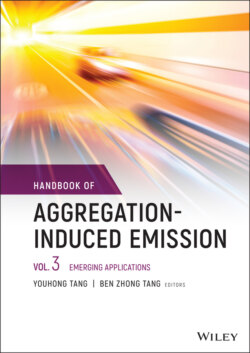Читать книгу Handbook of Aggregation-Induced Emission, Volume 3 - Группа авторов - Страница 40
3.3 AIE‐doped Polymer Films for Optical Sensing
ОглавлениеIn the introduction chapter, it was already reported that polymer films are the best candidate to promote the AIE technology also in the field of sensing. Notably, AIE polymers have many advantages over low‐mass AIEgens, such as processability, easy functionalization, good thermal stability, and possessing structural complexity and phase ordering that can be easily modulated by external solicitations [29, 30, 50]. The plastic matrix of the films actually allowed a prompt response to external solicitations such as a mechanical, a thermal, or a chemical solicitation by transferring the energy associated with the stimulus to the AIEgen molecules embedded in the film. Optical sensing is what we can define as the property of a traditional device to detect events and provide a corresponding optical output. A “good” optical sensor has to provide a fast change in optical response under stimuli of its environment by coming back to the pristine state in short time and by completely recovering the starting energy level. This is true if a reversible response is desirable or in the case of a reusable device. Quite often, in order to determine an external solicitation that could affect the structural integrity of a material, an irreversible optical response is highly advisable. This is, for example, the case of optical sensors based on doped polymer films utilized in smart and intelligent packaging, i.e. to monitor potential external contamination that could affect and deteriorate the quality of the contained object, most often food. According to the nature of the AIE aggregates in a poorly emissive amorphous or highly luminescent crystalline states, an OFF–ON or ON–OFF optical response can be obtained. In the following paragraphs, examples from the literature are provided in terms of the preparation and characterization of AIE‐doped polymer films as optical sensors able to detect mechanical stress (i.e. called mechanochromic) [16, 51], thermal solicitations (i.e. called thermochromic) [52], and the exposure toward VOCs (i.e. called vapochromic) [53].
